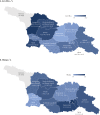Toward reaching hepatitis B goals: hepatitis B epidemiology and the impact of two decades of vaccination, Georgia, 2021
- PMID: 37498531
- PMCID: PMC10375835
- DOI: 10.2807/1560-7917.ES.2023.28.30.2200837
Toward reaching hepatitis B goals: hepatitis B epidemiology and the impact of two decades of vaccination, Georgia, 2021
Abstract
BackgroundGeorgia has adopted the World Health Organization European Region's and global goals to eliminate viral hepatitis. A nationwide serosurvey among adults in 2015 showed 2.9% prevalence for hepatitis B virus (HBV) surface antigen (HBsAg) and 25.9% for antibodies against HBV core antigen (anti-HBc). HBV infection prevalence among children had previously not been assessed.AimWe aimed to assess HBV infection prevalence among children and update estimates for adults in Georgia.MethodsThis nationwide cross-sectional serosurvey conducted in 2021 among persons aged ≥ 5 years used multi-stage stratified cluster design. Participants aged 5-20 years were eligible for hepatitis B vaccination as infants. Blood samples were tested for anti-HBc and, if positive, for HBsAg. Weighted proportions and 95% confidence intervals (CI) were calculated for both markers.ResultsAmong 5-17 year-olds (n = 1,473), 0.03% (95% CI: 0-0.19) were HBsAg-positive and 0.7% (95% CI: 0.3-1.6) were anti-HBc-positive. Among adults (n = 7,237), 2.7% (95% CI: 2.3-3.4) were HBsAg-positive and 21.7% (95% CI: 20.4-23.2) anti-HBc-positive; HBsAg prevalence was lowest (0.2%; 95% CI: 0.0-1.5) among 18-23-year-olds and highest (8.6%; 95% CI: 6.1-12.1) among 35-39-year-olds.ConclusionsHepatitis B vaccination in Georgia had remarkable impact. In 2021, HBsAg prevalence among children was well below the 0.5% hepatitis B control target of the European Region and met the ≤ 0.1% HBsAg seroprevalence target for elimination of mother-to-child transmission of HBV. Chronic HBV infection remains a problem among adults born before vaccine introduction. Screening, treatment and preventive interventions among adults, and sustained high immunisation coverage among children, can help eliminate hepatitis B in Georgia by 2030.
Keywords: Georgia; Hepatitis B; Hepatitis B vaccine; prevalence; serosurvey.
Conflict of interest statement
Figures



References
MeSH terms
Substances
LinkOut - more resources
Full Text Sources
Medical
Miscellaneous
